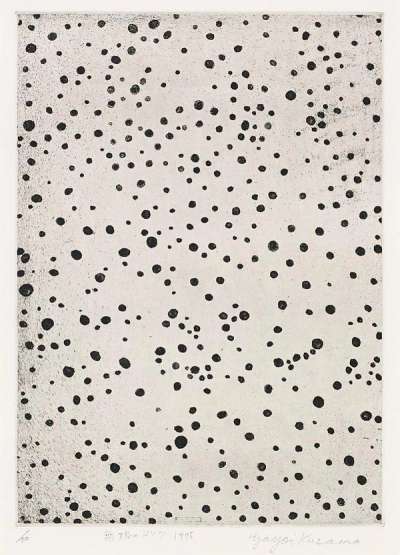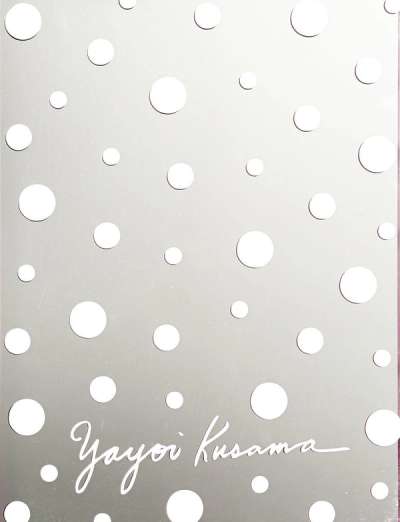The Symbolism of Polka Dots in Yayoi Kusama’s Art

 Dots Accumulation © Yayoi Kusama 1993
Dots Accumulation © Yayoi Kusama 1993
Yayoi Kusama
290 works
Key Takeaways
Yayoi Kusama revolutionised Abstract Expressionism with her distinctive use of polka dots, earning her the moniker 'Princess of Polka Dots.' Kusama's fascination with dots began in her childhood, stemming from hallucinations, and evolved into a central theme in her work, symbolising infinity, the cosmos, and personal healing. Her iconic polka dot motif is showcased in works such as her Infinity Rooms and Obliteration Rooms, to create a visual language of boundless space and meditative peace. Kusama's polka dots have left a lasting impact on contemporary art, inspiring generations and achieving widespread acclaim.
Within the aggressively-male dominated artscene of 1950s New York, Japanese artist Yayoi Kusama radically reinvented Abstract Expressionism through her fascination with polka dots. Undoubtedly her most iconic innovation, Kusama earned her nickname ‘Princess of Polka Dots’ through her creation of vast canvases repeatedly covered in hypnotic dots. Her early Infinity Nets and Dots paintings, with their meticulously repetitive style and unpredictable manifestation, demonstrated the available diversity within contemporary abstract art.
Watch Now: Yayoi Kusama's Endless Pursuit of InfinityKusama’s work not only had a profound impact on her contemporaries, including Andy Warhol and Claes Oldenburg, but her polka dots also served a functional role in helping her cope with her history of hallucinatory experiences. Kusama’s polka dots symbolise a grounding mechanism within the vast cosmos, transforming her frightening existential visions into peaceful meditations, and embodying her beliefs surrounding the universe and infinity. The enduring influence of her distinctive polka dot motif is showcased throughout her work, evidenced through prints such as Polka Dot Accumulation, Dots Infinity and her iconic series of Pumpkins.
Early Inspirations: Kusama's Introduction to Polka Dots
Childhood Experiences
Kusama’s fascination with polka dots began in her childhood, when at the age of ten, she had her first hallucination, describing it as flashings of light and dense fields of dots. These dots would become all consuming, and are responsible for the artist’s consistent theme of self-obliteration within her work. These visual obsessions left an indelible mark on Kusama’s creative psyche, and hugely influenced the prominence and status of the polka dot motif in her art.
Influence of Japanese Culture
Japanese culture also played a significant role in shaping Kusama’s artistic vision. Traditional Japanese art and textiles often feature repeating symbols, such as the Kikko pattern of hexagonal shapes, symbolising longevity and good fortune, or the Sakura pattern, featuring cherry blossoms that represent renewal and the transience of life. Kusama uniquely reinterprets these established motifs, and her expansive use of the polka dot is seen as a modern continuation of these cultural traditions.
Polka Dots as a Symbol of Infinity
The Infinite Universe and Cosmic Imagery
Kusama’s polka dots symbolise the infinite nature of the universe by representing boundless points with no conceivable ending, existing with the vastness of the cosmos. Each dot acts as a metaphor for stars or particles within the universe, embodying the idea of limitless space and time. This cosmic imagery reflects Kusama's fascination with the universe's endless possibilities, creating a visual language that articulates her childhood hallucinations.
Creating Immersive Experiences
Kusama brings her visions of infinity to life through her Infinity Rooms, her immensely popular public installations. She creates intensely immersive environments using rooms arranged with mirrors, lights and repeated dot patterns, designed to envelop her viewers in illusions of endless reflection. These environments challenge visitors' perceptions of space and time, and use her stylistic polka dot motif to encourage meditative contemplation on the infinite universe.
Polka Dots and Personal Expression
Representing Mental Health
Kusama’s use of polka dots is deeply related to her mental health. Kusama has verbalised the therapeutic nature of her work, her impressive portfolio serving as a mode of personal expression that helps her cope with inner anxieties. The repetitive nature of the dots, in works such as her Infinity Nets, provide a sense of control and order from her psychological trauma. Since 1977, Kusama has voluntarily lived in a psychiatric institution, where she continues to produce her work.
Art as a Therapeutic Outlet
By using art as a therapeutic outlet, Kusama is able to channel her psychological experiences into something tangible. The process of covering surfaces with dots becomes a meditative practice, helping her manage her mental health and find solace by remastering the polka dots she found so disturbing as a child.
The Unity and Dispersal of the Self
Dots as Cells and Particles
Polka dots not only represent concepts of infinity to Kusama, but they also explore Kusama’s experiences and ruminations on the subject of self-obliteration. Finding herself ‘obliterated’ in the hallucinatory visions she experienced in Japan, Kusama explores this alternate reality through visual processes that represent her own self-obliteration. By covering surfaces, objects, and even herself with dots, such as Self Obliteration by Dots (1968), Kusama symbolically disperses her identity into the universe.
The Concept of Self-Obliteration
Kusama’s philosophies surrounding the universe and her creation of ‘environmental’ art has led her to liken polka dots to cells and particles, the fundamental building blocks of life. Her analogy underscores the interconnectedness of all things, as well as representing a deconstruction of the self within the larger context of existence. Self-obliteration continues to be a recurring theme in Kusama's work, and is seen through her interactive installation, Obliteration Room.
Polka Dots in Kusama's Major Works
Infinity Rooms: The Endless Reflection of Dots
Kusama’s Infinity Rooms are perhaps the most iconic representation of her polka dot obsession. A significant contribution to her oeuvre and dating back to the 1960s, Kusama’s immersive installations offer a glimpse into her vision of infinity. Her first mirrored installation was Infinity Mirror Room: Phalli’s Field, in which Kusama encouraged viewer interaction by arranging hundreds of soft, phallic forms covered in red polka dots in a mirrored room. These rooms create an illusion of endless dots using strategically placed lights, mirrors and objects, which envelop visitors in a reflective, infinite space and provide an experience which is both disorienting and mesmerising. Her more recent instalments include her Infinity Mirrored Room—The Souls of Millions of Light Years Away and Infinity Mirrored Room—Aftermath of Obliteration of Eternity.
Pumpkin Sculptures: Merging Natural Forms with Polka Dots
Pumpkins are also a recurring motif within Kusama’s work, and merge natural forms with her iconic dotted patterns. These works highlight the interplay between nature and Kusama's distinctive pattern, transforming everyday objects into symbols of infinity and self-obliteration.
Obliteration Room: Interactive Art with Dots
An alternative exploration of self-obliteration, Kusama’s Obliteration Room invited visitors to participate in her creative visions by placing countless, coloured polka dot stickers anywhere they could within a white, furnished room. This interactive installation aimed to democratise the artistic experience, allowing participants to contribute to the obliteration of a space and engage viewers as active participants in the creation of contemporary art.
 Image © Creative Commons (via flickr) / Obliteration Room (Gallery of Modern Art, Brisbane)© Yayoi Kusama 2015
Image © Creative Commons (via flickr) / Obliteration Room (Gallery of Modern Art, Brisbane)© Yayoi Kusama 2015 The Cultural Impact of Kusama's Polka Dots
Influence on Contemporary Art
The world’s top-selling female artist, Kusama’s innovative use of polka dots has significantly influenced contemporary art and inspired new generations of artists to experiment with new forms of visual expressionism through patterns, repetition and immersive art. Her work challenges conventional notions of space, identity and infinity, blending aspects of traditional Japanese culture with her own unique vision of the world.
Public Reception and Popularity
Kusama’s polka dot works have achieved immense popularity, resonating with audiences worldwide. She is one of the most famous artists on instagram, her Infinity Rooms earning her the accolade of ‘most instagrammable’ artist, and witnessing celebrity visitors including Katy Perry and Adele. The universal appeal of polka dots, combined with Kusama’s unique vision, has made her art both accessible and utterly transcendent.
The Lasting Legacy of Kusama's Polka Dots
Yayoi Kusama's polka dots have transcended their humble origins and become a recognisable symbol of infinity, personal expression, and cosmic unity. Acting as deeply personal expressions of childhood hallucinations and mental health struggles, Kusama's dots have evolved into a universal language that speaks to the vastness of the cosmos and the interconnectedness of all things. Her innovative use of polka dots not only revolutionised Abstract Expressionism, but continues to influence the contemporary art scene.
Through her Infinity Nets, Pumpkins and Infinity Rooms, Kusama has created works and experiences that resonate deeply with audiences, offering meditative reflections on obliteration and the infinite universe. The enduring appeal of her polka dots lies in their simplicity and symbolism, making her one of the most beloved and influential artists of our time. Kusama's legacy continues to inspire and captivate artists and viewers, ensuring that her vision of infinity and self-obliteration remains an integral part of the art world's narrative.




















